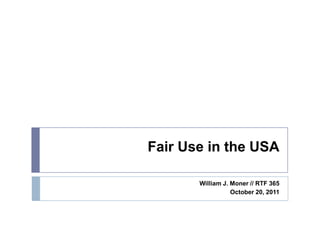Fair Use Lecture
- 1. Fair Use in the USA William J. Moner // RTF 365 October 20, 2011
- 2. Course Notes ï― Craig Aaron ï― http://www.freepress.org ï― Papers ï― upload it to two places on blackboard: the Discussion Board as well as the Assignment area.
- 3. Quick Recap ï― U.S. Constitution, Article I, Section 8, clause 8 ï― Congress shall have the power: "To promote the Progress of Science and useful Arts, by securing for limited Times to Authors and Inventors the exclusive Right to their respective Writings and Discoveries." ï― U.S. major laws: 1790, 1831, 1870, 1909, and 1976, plus the Digital Millennium Copyright Act (DMCA) of 1998 ï― Twelve extensions of the term of copyright, including retroactive extensions in the past few decades.
- 4. What is Copyright Infringement? ï― A violation of three elements: ï― Originality ï― Access ï― Substantial Similarity
- 5. What is Originality? ï― Ex nihilo? ï― Or simply âoriginal enoughâ
- 6. What is Access? ï― If you donât know it exists, you canât copy it
- 7. What is Substantial Similarity? ï― Distinction between exact replicas/copies and similarity ï― The scientific proof? âReasonable Personâ test
- 8. What can be used without fear of copyright violation? ï― Facts ï― Ideas ï― Public Domain Materials ï― Idea/Expression Merger ï― scenes-a faire doctrine
- 9. What about Copyrighted Works?
- 12. Fair Use ï― The most commonly invoked defense against copyright infringement claims ï― To use this defense, defendants must admit to copying the plaintiffâs work
- 13. Four Inquiries ï― Copyright Code, Section 107 of Title 17 of US Code (17 USC 107) ï― Purpose and Character of the use ï― Nature of the Work ï― Amount Taken ï― The Effect of the Taking on the Copyrightâs Value
- 14. Additional Inquiries (not in Code): ï― Noted by observation of recent case law: ï― The Intent and Motives of the Defendants ï― The relationship of the âuseâ to the exercise of free speech ï― Miller & Davis (1990, pp. 349-350)
- 15. Decisions Must Satisfy a Combination of these Inquiries ï― In other words, these inquiries are interdependent
- 16. Inquiry 1: The Purpose and Character of the Use ï― Non-profit educational uses (within limits) ï― âcriticism, comment, news reporting, teaching (including multiple copies for classroom use), scholarship, or researchâ
- 17. Purpose and CharacterâĶ ï― âPretty Womanâ by 2 Live Crew is protected as parody ï― âThe Cat Not in the Hat: A Parody by Dr. Juiceâ by Alan Katz is not protected as parody
- 18. Purpose and CharacterâĶ ï― Naked Gun / More Demi Moore
- 19. Purpose and CharacterâĶ Sony VCRs
- 20. Purpose and Character âĶ ï― Non-profit educational use guidelines: ï― Brevity ï― Spontaneity ï― Cumulative effect From Agreement on Guidelines for Classroom Copying in Not-for-Profit Educational Institutions (Classroom Guidelines) ï― Distinction between not-for-profit and commercial
- 21. Inquiry 2: The Nature of the Work ï― Works not yet published ï― e.g. Fordâs biography, Hubbardâs biography ï― Counts against assertion of fair use, but not solely a determining factor (as is the case with most individual inquiries) ï― Facts and Statistics vs. Creative or Imaginative Work: which is more easily defensible?
- 22. Inquiry 3: The Amount or Proportion Taken âthe amount and substantiality of the portion used in relation to the copyrighted work as a wholeâ (from 17 USC 107) ï― Dependent upon nature of the work and the nature of the use ï― Parodies can take more; commercial derivatives canât borrow as freely
- 23. Inquiry 4: The Effect on Value / Economic Harm ï― Justice OâConnor: this inquiry âis undoubtedly the single most important element of fair use.â ï― Letâs talk about the Sony case âĶ does the VCR and taping of programs or videos effect the value of a given commercial productâs copyright?
- 24. The Effect of âTakingââĶ ï― Literary works such as The Seinfeld Aptitude Test or Welcome to Twin Peaks: A Complete Guide to Whoâs Who and Whatâs What ï― Why hasnât anyone sued Girl Talk? Or Kutiman?
- 25. Girl Talk & Kutiman (time permitting) ï― Great site for sampling research: ï― http://www.whosampled.com/ ï― Why hasnât Girl Talk been sued? ï― Kutiman: http://thru-you.com/#/intro/
- 26. I Got AMashupâĶ Legendary K.O. via Kanye West via Ray Charles via? From Boyle (2008) The Public
- 27. References: ï― 2 Live Crew. âPretty Woman.â Accessed via Spotify. ï― Aoki, K., Boyle, J., Jenkins, J. âBound By Law: Tales from the Public Domain.â Duke Center for the Study of the Public Domain. Retrieved from http://www.law.duke.edu/cspd/comics/digital.php ï― Benedict.com. âAnnie Liebovitz and the Naked Gun.â http://www.benedict.com/Visual/Nakedgun/Nakedgun.aspx ï― Boyle, J. (2008) The Public Domain. Chapter 6. http://www.thepublicdomain.org/download/ ï― Charles, R. âI Got a Womanâ http://www.youtube.com/watch?v=Mrd14PxaUco ï― Legendary K.O. âBush donât like black people.â http://www.youtube.com/watch?v=LOu_zIiihPI ï― Minâs Blog. âSatire or Parody?â http://blogs.law.harvard.edu/yuminemma/2009/12/16/satire-or-parody-dr-seuss- enterprises-v-penguin-books-usa/ ï― Orbison, R. âOh Pretty Woman.â Accessed via Spotify. ï― Siegel, P. (2008). Communication Law in America: Second Edition. Chapter 6. ï― Traditional. âJesus is All the World to Me.â http://www.youtube.com/watch?v=0dY4h1P0OPs ï― West, K. âGold Digger ft. Jamie Foxx.â http://www.youtube.com/watch?v=6vwNcNOTVzY



























